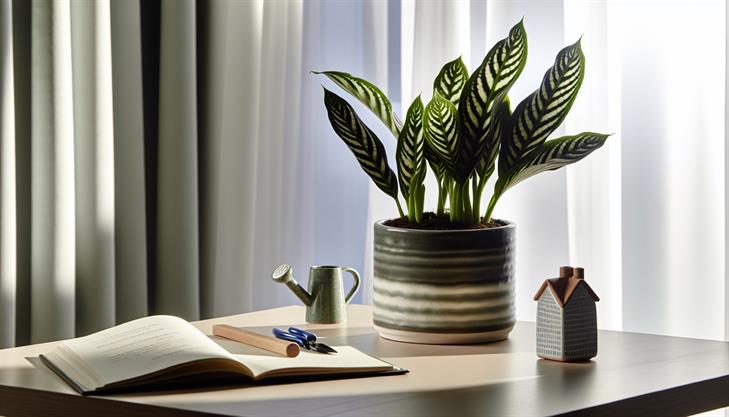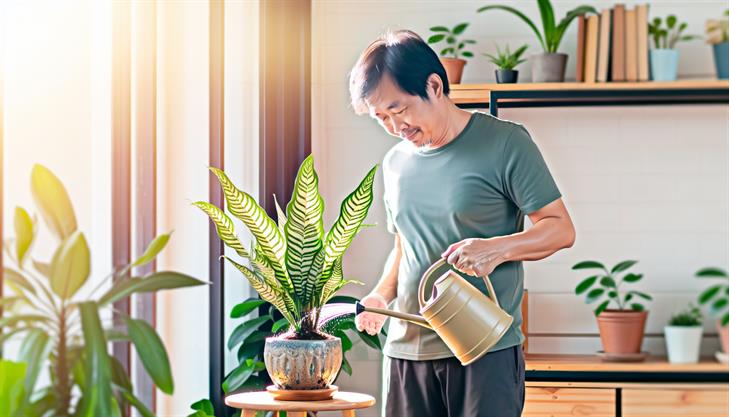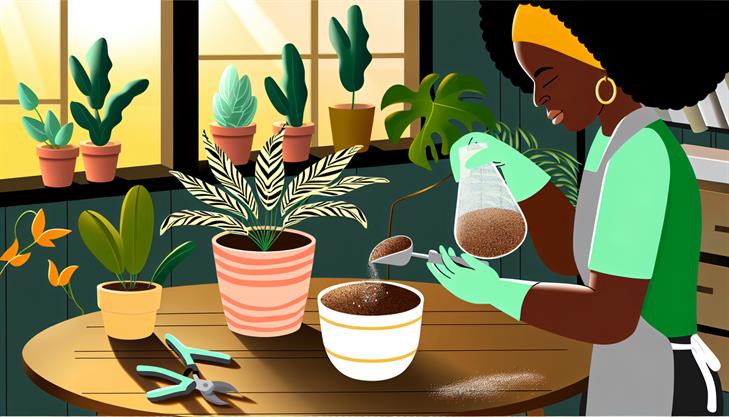Houseplants have taken the world by storm in recent years, gracing homes with their lush greenery and decorative appeal. Among these verdant marvels, the zebra plant (Aphelandra squarrosa) stands out for its striking foliage — a visual treat of glossy green leaves striped with dramatic white veins. However, the zebra plant is more than just a showstopper; it’s a horticultural challenge that puts even seasoned plant enthusiasts to the test. Why does this plant demand our attention and care? Because when nurtured correctly, it rewards its caretaker with breathtaking, bright yellow blooms that are well worth the effort. In this comprehensive guide, we will unravel the mystery of maintaining the ideal balance of light, humidity, and nourishment that the zebra plant craves. Whether you’re a newbie plant parent or a green-thumbed veteran, understanding the unique needs of this tropical beauty can transform your space into a thriving haven. So, dive in to discover essential tips and expert tricks that will keep your zebra plant healthy, vibrant, and perennially admired.
Understanding Zebra Plant Basics
The zebra plant, known scientifically as Aphelandra squarrosa, is a striking houseplant celebrated for its bold, dark green leaves adorned with white stripes. Its unique appearance makes it a popular choice among indoor plant enthusiasts. Caring for a zebra plant isn’t overly complicated, but it does have specific needs to thrive successfully in a home setting. Here’s a step-by-step guide on how to care for a zebra plant to ensure it remains vibrant and healthy.
Lighting Requirements
Zebra plants flourish in bright, indirect light. Direct sunlight can scorch their leaves, so it’s ideal to place them near a window that gets filtered light. If your home doesn’t get enough natural light, consider using a grow light to supplement.
Watering Guidelines
Zebra plants prefer consistently moist soil, but not soggy. During the growing season (spring and summer), water the plant when the top inch of the soil feels dry to the touch. Reduce watering frequency in the fall and winter, allowing the top two inches of soil to dry out between waterings. Over-watering can lead to root rot, so ensure proper drainage.
Humidity and Temperature
Zebra plants thrive in high humidity environments. To maintain optimal humidity, mist the leaves regularly or place a humidifier nearby. Alternatively, setting the pot on a tray filled with pebbles and water can help increase humidity as the water evaporates. Keep the temperature consistently between 65°F and 75°F (18°C to 24°C), avoiding cold drafts and sudden temperature changes.
Soil and Fertilization
Use a well-draining potting mix, ideally one that’s rich in organic matter. A mix specifically designed for tropical houseplants is recommended. During the growing period, fertilize the zebra plant every four to six weeks with a balanced, water-soluble fertilizer at half strength. Avoid fertilizing in the winter when the plant is not actively growing.
Pruning and Repotting
Prune your zebra plant to maintain its shape and encourage bushier growth. Remove any dead or yellowing leaves promptly. Repotting should be done every two to three years or when you notice roots growing out of the drainage holes. Choose a slightly larger pot to give the roots space to grow.
Common Issues and Solutions
- Leaf Drop and Browning Tips: Often a sign of insufficient humidity or inconsistent watering. Ensure the plant is receiving adequate moisture and humidity.
- Pest Infestation: Mealybugs and spider mites can be a problem. Inspect regularly and, if needed, clean with a damp cloth or apply an insecticidal soap.
- Slow Growth: If your plant appears stunted, check the lighting conditions and fertilization schedule. It may need more light or nutrients.
Additional Advice
- Location: Positioning your zebra plant in the bathroom can naturally maintain higher humidity levels, provided it receives adequate light.
- Propagation: Zebra plants can be propagated using stem cuttings. In the spring, take a cutting with at least one healthy leaf node, dip it in rooting hormone, and plant it in moist potting soil.
By following these care instructions, your zebra plant should thrive and continue to be a stunning addition to your indoor garden. With the right setup and a little patience, even novice plant caretakers can successfully nurture this beautiful tropical species.
Step-by-Step Zebra Plant Watering Guide
Zebra plants, also known as Aphelandra squarrosa, are attractive houseplants cherished for their striking dark green leaves with white veins. These tropical beauties can be a bit finicky, but with the right care, they can thrive indoors. Here is a step-by-step zebra plant watering guide accompanied by overall care tips to ensure your zebra plant remains healthy and vibrant.
Understand the Watering Needs
Step 1: Check Moisture Level Regularly
- Frequency: Zebra plants require consistently moist soil. Check the soil moisture by inserting your finger about an inch deep. If the soil feels dry, it’s time to water.
- Tip: Use a moisture meter for precision, which can help avoid overwatering—one of the most common mistakes in zebra plant care.
Step 2: Water Thoroughly
- Method: When watering, do so until water drains from the bottom to ensure even soil saturation.
- Tip: Discard any excess water in the saucer to prevent root rot.
Step 3: Monitor Water Type and Quality
- Best Practices: Use room-temperature, distilled, or rainwater. Tap water can contain chemicals like fluoride and chlorine that might harm the plant over time.
Light and Temperature Requirements
Step 4: Ensure Adequate Lighting
- Environment: Position your zebra plant in bright, indirect light. Direct sunlight can scorch its leaves, while too little light will stunt growth.
- Setup Tip: Near a north or east-facing window is ideal. Consider using sheer curtains if the plant is exposed to harsh sunlight.
Step 5: Maintain Ideal Temperatures
- Conditions: Zebra plants thrive in temperatures between 65°F and 75°F (18°C to 24°C). Avoid placing them near drafts or direct heat sources.
- Tip: Humidity is crucial—consider a humidifier, or place the pot on a tray filled with pebbles and water to increase humidity levels.
Pruning and Feeding
Step 6: Prune Regularly
- Why: Encourages fuller growth and removes dead or yellowing leaves.
- How-To: Use clean, sharp scissors to cut back any overgrown or unhealthy foliage.
Step 7: Fertilize Appropriately
- Schedule: During the growing season (spring and summer), use a balanced liquid fertilizer diluted to half strength every 4 to 6 weeks.
- Advice: Avoid over-fertilization, as this can lead to root damage or leaf burn.
Common Issues and Solutions
Problem: Drooping Leaves
- Cause: Usually a sign of over or underwatering.
- Solution: Adjust your watering schedule, ensuring the soil is evenly moist and not soggy.
Problem: Brown Leaf Tips
- Cause: This can result from low humidity or mineral build-up from tap water.
- Solution: Increase humidity and switch to distilled or rainwater.
By following this step-by-step guide on how to care for a zebra plant, you’ll be well on your way to fostering an environment where your plant can flourish. Remember, consistency in care is key, and with patience, you’ll enjoy the lush, vibrant appearance that makes the zebra plant a standout addition to any indoor space.
Optimal Light and Temperature Tips for Zebra Plants
Zebra plants, known for their striking, striped foliage, make a stunning addition to any indoor garden. However, caring for these beautiful plants requires attention to their specific needs, particularly concerning light and temperature. Understanding the optimal conditions for your zebra plant can help ensure it thrives, adding vibrant life to your living space.
Ideal Lighting Conditions
Zebra plants thrive under bright, indirect light. Direct sunlight can scorch their leaves, causing the iconic white stripes to fade, while too little light may lead to leggy growth and a lack of flowering. Here’s how to achieve the right balance:
-
Locate the Optimal Spot: Position your zebra plant near a window that receives filtered light, such as through sheer curtains, or place it in a well-lit room away from direct sunlight. Eastern or northern exposure windows are often ideal as they provide gentle morning light that isn’t too intense.
-
Monitor and Adjust: Regularly check the intensity of light your zebra plant receives. If you notice the leaves losing their vibrancy or becoming scorched, try moving the plant a few feet away from the source or add a thin curtain to diffuse the light.
Temperature and Humidity Preferences
Zebra plants hail from Brazilian rainforests, implying they flourish in warm, humid environments. Maintaining the right temperature and humidity levels is crucial:
-
Maintain Consistent Temperatures: Aim to keep indoor temperatures between 65°F and 75°F. Zebra plants are sensitive to drastic temperature changes and cold drafts, so avoid placing them near air conditioners, heaters, or open windows during colder months.
-
Boost Humidity Levels: Since zebra plants prefer higher humidity, aim for a humidity level of around 60-70%. You can increase moisture in the air by placing a small humidifier nearby, using a pebble tray filled with water under the plant pot, or grouping it with other plants to form a mini humid microclimate.
Watering Regimen
Watering zebra plants requires a balanced approach, as both overwatering and underwatering can cause issues:
-
Check Soil Moisture: Keep the potting soil consistently moist during the growing season (spring and summer), but not soggy. A good rule of thumb is to water when the top inch of soil feels dry to the touch.
-
Adjust in Dormant Periods: In fall and winter, when growth slows, water less frequently but still ensure the soil doesn’t completely dry out.
Common Issues and Solutions
-
Wilting Leaves: Often a result of incorrect watering. Ensure you’re not over-saturating the soil and that the pot provides adequate drainage.
-
Leaf Browning or Yellowing: This may indicate too much direct sunlight or a substance build-up in the soil. Consider adjusting the light exposure and flushing the soil with clean water to remove potential harmful deposits.
-
Failure to Flower: Zebra plants may not bloom if they don’t receive the proper care. Ensure optimal light and humidity conditions, and consider feeding the plant with a balanced fertilizer during its growing season.
Additional Care Tips
-
Repotting: Plan to repot your zebra plant every two to three years during early spring. This will refresh the soil and provide room for growth.
-
Pruning: Regularly remove any yellowed or dead leaves to encourage healthy growth and maintain an attractive appearance.
By following these guidelines on how to care for a zebra plant, you can foster an optimal environment that supports its growth and beauty. With proper light, temperature, and care, your zebra plant will thrive, rewarding you with its stunning foliage and occasional flowers.
Fertilizing and Pruning for Healthy Growth
Caring for a zebra plant (Aphelandra squarrosa) requires a keen understanding of its specific needs, as this tropical beauty can be quite particular. Zebra plants, known for their striking bright leaves and vivid yellow bracts, thrive when provided with the right environment and care routine.
Understanding the Ideal Conditions
First and foremost, replicating the zebra plant’s natural habitat is key. Native to the Brazilian rainforests, these plants prefer high humidity and warmth. Place your zebra plant in a spot where it receives bright, indirect light. Direct sunlight can scorch the leaves, while too little light may lead to leggy growth. Consider using sheer curtains to diffuse sunlight.
Watering Guidelines
Proper watering is crucial for zebra plant care. The soil should remain consistently moist but not soggy. Allow the top inch of soil to dry out before rewatering. During the growing season (spring and summer), you may need to water more frequently, whereas in the fall and winter, watering can be reduced. Always use room-temperature water to prevent shocking the plant.
Humidity and Temperature Needs
These plants flourish in environments with humidity levels above 60%. If your home is dry, particularly in winter, use a pebble tray or a humidifier to boost moisture around the plant. Misting can also help but avoid spraying directly onto the leaves to prevent spotting. The ideal temperature range for a zebra plant is between 65°F and 75°F (18°C-24°C). Keep them away from drafts or sudden temperature changes, as these can cause stress and damage.
Soil and Fertilization
Well-draining potting soil, rich in organic matter, is essential. A mix containing peat, perlite, and pine bark works well. Zebra plants benefit from a balanced, water-soluble fertilizer every two weeks during the growing season. Reduce feeding in the winter when growth slows. Be cautious not to over-fertilize, as excess nutrients can harm the plant.
Pruning for Health
Pruning helps maintain a zebra plant’s shape and encourages denser growth. Trim any dead or yellowing leaves with sterilized scissors to prevent disease. After the plant has finished flowering, cut back the flowering spike to the second set of leaves to promote new growth.
Common Issues and Solutions
Zebra plants are prone to a few common problems. Drooping leaves can indicate under-watering, over-watering, or low humidity. Monitor your watering schedule and adjust humidity levels as needed. Brown leaf tips often result from dry air; increasing humidity and consistent watering usually mitigates this issue.
Additionally, watch for pests like aphids and spider mites. In case of an infestation, treat the plant with insecticidal soap or neem oil, ensuring to follow application instructions carefully.
Additional Tips
Rotate your zebra plant periodically to ensure even growth and prevent it from leaning towards the light source. Repot every couple of years in fresh soil to encourage healthy root development and provide space for growth. By adhering to these care guidelines, your zebra plant will remain vibrant and healthy, adding a touch of exotic beauty to your home.
Troubleshooting Common Zebra Plant Issues
Caring for a Zebra Plant (Aphelandra squarrosa) can be a rewarding experience, as this tropical beauty with its striking, glossy green and white striped leaves can brighten up any indoor space. However, it does have specific care requirements that need to be met to maintain its health and encourage its stunning yellow blooms. Here’s a step-by-step guide on how to care for a zebra plant effectively:
1. Selecting the Right Spot
Light Requirements: Zebra plants thrive in bright, indirect light. Too much direct sunlight can scorch their leaves, while insufficient light may cause leaves to lose their vibrant patterns. Place them near a north or east-facing window where they can enjoy softer daylight.
Temperature and Humidity: Native to Brazilian rainforests, zebra plants prefer temperatures between 65°F to 80°F (18°C to 27°C). They also need high humidity levels of 60% or more. Consider positioning them in a naturally humid room, like a bathroom, or use a humidity tray or humidifier to maintain optimum conditions.
2. Watering Guidelines
Watering Needs: Zebra plants require consistently moist soil but do not tolerate waterlogged roots. Water them once the top inch of soil feels dry, ensuring the pot has good drainage. In winter, when growth slows, reduce watering frequency.
Water Quality: Using distilled or rainwater is recommended, as they can be sensitive to the salts and chemicals found in tap water.
3. Soil and Repotting
Soil Type: Use a well-draining potting mix rich in organic material. A combination of peat, perlite, and pine bark can provide suitable conditions for their roots.
Repotting Frequency: Repot your zebra plant every two to three years or when it outgrows its pot. The best time is during the growing season, usually in spring or summer.
4. Fertilizing
Fertilization Schedule: From spring through the early fall, feed your zebra plant every two weeks with a balanced, water-soluble fertilizer at half strength. Cease fertilization during the winter months when the plant’s growth naturally slows.
5. Pruning and Cleaning
Pruning Needs: Regular pruning helps maintain a compact shape and encourages bushier growth. Remove any spent flowers, as well as dead or yellowing leaves, to promote healthy growth.
Cleaning Leaves: Dusty leaves can inhibit photosynthesis, so gently wipe them with a damp cloth to keep them clean and shiny.
Common Issues and Solutions
-
Leaf Drop: Often due to insufficient humidity or sudden temperature changes. Ensure stable temperatures and higher humidity levels.
-
Yellow Leaves: Can indicate overwatering. Allow the soil to dry out a bit more between waterings.
-
Browning Tips: Usually a result of low humidity. Increase humidity around the plant to prevent this issue.
-
Pest Problems: Aphids and spider mites can pose a problem. Treat infestations with insecticidal soap or neem oil, and ensure the plant has adequate airflow.
Additional Tips
- Pot Choice: Use a pot with drainage holes to prevent soggy roots, a common issue for zebra plants.
- Plant Rotation: Rotate your zebra plant occasionally to ensure even growth and consistent lighting to all sides.
By following these tips on how to care for a zebra plant, you can maintain its dazzling appearance and enjoy its unique foliage year-round. With the right care routine, your zebra plant will flourish beautifully in your home.
Caring for a zebra plant can be a rewarding experience, adding vibrant greenery and unique flair to your indoor space. In this post, we explored the essential aspects of taking care of your zebra plant, from understanding its optimal lighting conditions to maintaining the right humidity levels. Remember, zebra plants thrive in bright, indirect sunlight and require consistently moist soil without becoming waterlogged. Regularly misting the leaves can mimic their native humid environment, preventing leaf trauma and promoting healthy growth. Monitoring the plant for signs of distress, such as yellowing leaves or wilting, will ensure you can make timely adjustments to its care routine.
As you apply these strategies, you’ll find that your zebra plant not only survives but flourishes, enhancing your home or office with its striking striped foliage. To further encourage optimal health and growth, consider occasionally rotating your plant to ensure all sides receive equal exposure to light, preventing uneven growth and promoting a symmetrical appearance. Your commitment to understanding and meeting your zebra plant’s needs will undoubtedly lead to a thriving, beautiful addition to your plant collection. Happy growing!


